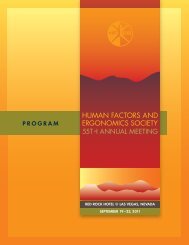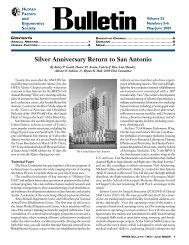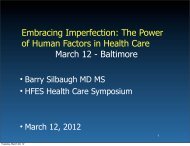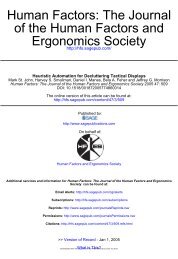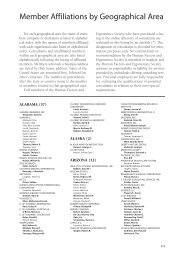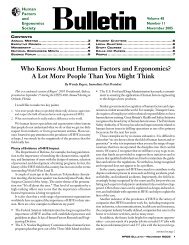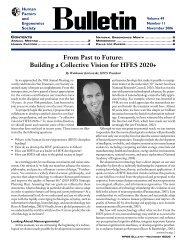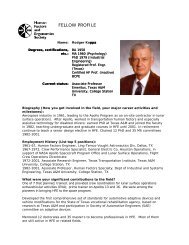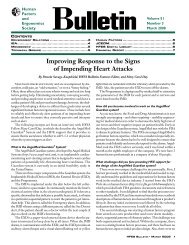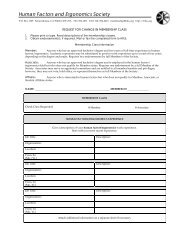MOBILE-READY - Human Factors and Ergonomics Society
MOBILE-READY - Human Factors and Ergonomics Society
MOBILE-READY - Human Factors and Ergonomics Society
Create successful ePaper yourself
Turn your PDF publications into a flip-book with our unique Google optimized e-Paper software.
4. Richard R. Goodenough, Johnell O. Brooks, <strong>and</strong>Matthew C. Crisler, Clemson U.; William L.Logan, Palmetto Health, Developing a NewDriving Simulator Task to Assess Drivers’Functional Object Detection5. Soyun Kim, Michael S. Wogalter, <strong>and</strong> ChristopherB. Mayhorn, North Carolina State U., Older <strong>and</strong>Younger Drivers’ Beliefs About Motor VehicleFeatures to Benefit Their Safe DrivingAC1 – RESEARCH AND METHODSPERTAINING TO EEGLectureTuesday, September 28, 2010, 3:30 to 5:00 p.m.Seacliff A (Bay Level)Augmented CognitionChair: Lee W. Sciarini, Naval Air Warfare Ctr.; Cochair:Irwin Hudson, U.S. Army Research Lab1. Ronald H. Stevens <strong>and</strong> Trysha L. Galloway,UCLA School of Medicine, IMMEX Project;Chris Berka <strong>and</strong> Adrienne Behneman, AdvancedBrain Monitoring, Inc., Temporal Sequences ofNeurophysiologic Synchronies Can IdentifyChanges in Team Cognition2. Grant Taylor <strong>and</strong> Lauren Reinerman-Jones, U. ofCentral Florida; Keryl Cosenzo, U.S. ArmyResearch Lab; Denise Nicholson, U. of CentralFlorida, Comparison of Multiple PhysiologicalSensors to Classify Operator State inAdaptive Automation Systems3. Daniel M. Roberts, Brian A. Taylor, Jane H.Barrow, Geoffrey Robertson, <strong>and</strong> George Buzzell,George Mason U.; Ciara Sibley <strong>and</strong> Anna Cole,Strategic Analysis Inc.; Joseph Coyne, U.S. NavalResearch Lab; Carryl Baldwin, George Mason U.,EEG Spectral Analysis of Workload for aPart-Task UAV Simulation4. Deepika Dasari, Chris Crowe, Chen Ling, MinZhu, <strong>and</strong> Lei Ding, U. of Oklahoma, EEGPattern Analysis for Physiological Indicatorsof Mental Fatigue in Simulated Air TrafficControl Tasks5. Justin R. Estepp, Jason W. Monnin, <strong>and</strong> James C.Christensen, U.S. Air Force Research Lab; GlennF. Wilson, Physiometrix, Inc., Evaluation of aDry Electrode System for Electroencephalography:Applications for PsychophysiologicalCognitive Workload AssessmentAS3 – NEXTGEN: UNDER CONSTRUCTION—WORKS IN PROGRESS TO ENHANCEAVIATION OPERATIONSDiscussion PanelTuesday, September 28, 2010, 3:30 to 5:00 p.m.Gr<strong>and</strong> Ballroom C (Street Level)Aerospace SystemsChair: Amy Alex<strong>and</strong>er, Aptima Inc.Panelists: Paul Picciano, Aptima Inc.; Thomas B.Sheridan, Massachusetts Inst. of Technology; LauraStrater, SA Technologies; Nathan Schurr, Aptima Inc.;John-Paul Clarke, Georgia Tech; Vikram Manikonda,Intelligent Automation, Inc.CE3 – WORKLOAD AND SITUATION AWARE-NESSLectureTuesday, September 28, 2010, 3:30 to 5:00 p.m.Gr<strong>and</strong> Ballroom B (Street Level)Cognitive Engineering & Decision MakingChair: Lisa Jo Elliott, New Mexico State U.; Cochair:Jennifer Riley, SA Technologies1. Jason Ralph, Wayne D. Gray, <strong>and</strong> Michael J.Schoelles, Rensselaer Polytechnic Inst.,Squeezing the Balloon: Analyzing theUnpredictable Effects of Cognitive Workload2. Rosemarie E. Yagoda, North Carolina State U.,Development of the <strong>Human</strong>-Robot InteractionWorkload Measurement Tool (HRI-WM)3. Haydee M. Cuevas <strong>and</strong> Cheryl A. Bolstad, SATechnologies, Influence of Team Leaders’Situation Awareness on Their Team’sSituation Awareness <strong>and</strong> Performance4. Lelyn D. Saner, U. of Maryl<strong>and</strong>; Cheryl A.Bolstad, SA Technologies; Cleotilde Gonzalez,Carnegie Mellon U.; Haydee M. Cuevas, SATechnologies, Predicting Shared SituationAwareness in Teams: A Case of DifferentialSA Requirements5. An<strong>and</strong> Tharanathan, Honeywell ACS Labs; PeterBullemer, <strong>Human</strong> Centered Solutions, LLC;Jason Laberge, Honeywell ACS Labs; Dal VernonReising <strong>and</strong> Rich Mclain, <strong>Human</strong> CenteredSolutions, LLC, Functional Versus SchematicOverview Displays: Impact on OperatorSituation Awareness in Process MonitoringFP1 – FORENSICS CHALLENGES IN HUMANFACTORS AND ERGONOMICSLectureTuesday, September 28, 2010, 3:30 to 5:00 p.m.Seacliff B (Bay Level)Forensics ProfessionalChair: Erin Alves, Raytheon; Cochair: Tonya Smith-Jackson, Virginia Tech1. Shelley Waters Deppa, Safety Behavior Analysis,Inc.; Carol Pollack-Nelson, Independent SafetyConsulting; Elaine D. Allen, Safety BehaviorAnalysis, Inc., So Your Consumer ProductComplies With the Voluntary SafetySt<strong>and</strong>ard—Now What?2. Genevieve M. Heckman <strong>and</strong> Erin M. Harley,Exponent Failure Analysis; Irving Scher,Guidance Engineering <strong>and</strong> Applied Research;Douglas E. Young, Exponent Failure Analysis,Helmet Use in Sledding: Do Users ComplyWith Manufacturers’ Warnings?3. Kenneth Nemire, HFE Consulting, LLC; DavidA. Thompson, Portola Assoc., Inc.; H. HarveyCohen, Error Analysis, Inc., Stick-<strong>and</strong>-Fall: APreviously Unstudied Type of Fall4. Kenneth Nemire, HFE Consulting LLC, CaseStudy: Wheelchair Conspicuity at Night5. Farheen S. Khan, Joseph B. Sala, <strong>and</strong> Steven R.Arndt, Exponent Failure Analysis, ReducingSubjectivity When Attempting Auditory SceneRecreation in Accident ReconstructionHC3 – SUPPORTING COGNITION AND DECI-SION MAKING IN CLINICAL WORKDiscussion PanelTuesday, September 28, 2010, 3:30 to 5:00 p.m.Garden Room B (Atrium Lobby Level)Health CareChair: Paul Gorman, Oregon Health & Science U.;Cochair: Elizabeth Canzone, Old Dominion U.Panelists: Joshua Richardson, Oregon Health &Science U.; Alissa Russ, Roudebush VA Medical Ctr.;Laura G. Militello, U. of Dayton Research Inst.; YanXiao, Baylor Health Care SystemID1 – INDIVIDUAL DIFFERENCES IN AFFEC-TIVE TRAITS AND STATESLectureTuesday, September 28, 2010, 3:30 to 5:00 p.m.Seacliff D (Bay Level)Individual Differences in PerformanceChair: Carryl Baldwin, George Mason U.1. James L. Szalma <strong>and</strong> Grace W. L. Teo, U. ofCentral Florida, The Joint Effect of TaskCharacteristics <strong>and</strong> Neuroticism on thePerformance, Workload, <strong>and</strong> Stress of SignalDetection2. Almira Kustubayeva, Kazakh National U.; AprilRose Panganiban <strong>and</strong> Gerald Matthews, U. ofCincinnati, Affective Biases in InformationSearch During Tactical Decision Making3. Paula Desmond, Lauren Margulieux, AddisonEnglish, <strong>and</strong> Alex<strong>and</strong>ra Burbey, Southwestern U.;Gerald Matthews, U. of Cincinnati, EmotionalIntelligence <strong>and</strong> Driver Stress4. Joel Suss <strong>and</strong> Paul Ward, Michigan TechnologicalU., Skill-Based Differences in the CognitiveMechanisms Underlying Failure UnderStress5. Tak C. Woo, William S. Helton, <strong>and</strong> Paul N.Russell, U. of Canterbury, The Role Emotion<strong>and</strong> Gender Play in the Choice of Commutingby Bicycle: A Preliminary Study FromChristchurch, New Zeal<strong>and</strong>PD3 – NINTH ANNUAL USER-CENTEREDPRODUCT DESIGN AWARD SESSIONAlternative FormatTuesday, September 28, 2010, 3:30 to 5:00 p.m.Gr<strong>and</strong> Ballroom A (Street Level)Product DesignChair: Dianne L. McMullin, Boeing Co.; Cochair:Stanley H. Caplan, Usability Assoc.PP1 – PERCEPTION & PERFORMANCEPOTPOURRI 1LectureTuesday, September 28, 2010, 3:30 to 5:00 p.m.Bayview Room B (Bay Level)Perception & PerformanceChair: Paul R. Havig, U.S. Air Force Research Lab1. Wayne Giang, U. of Waterloo; Allan Keefe,Defence Research <strong>and</strong> Development Canada;Jocelyn Keillor, National Research Council ofCanada, Effect of Brightness of Assisted TargetDetection Cues in a Simulated Search <strong>and</strong>Rescue Task2. Katherine A. Tarling <strong>and</strong> Duncan P. Brumby, U.College London, Density Guides Visual Search:Sparse Groups Are First Even When Slower3. Thomas Ferris, Kiana Stringfield, <strong>and</strong> NadineSarter, U. of Michigan, Tactile “Change Blindness”in the Detection of Vibration Intensity4. Yarden Moskovitch, Myounghoon Jeon, <strong>and</strong>Bruce N. Walker, Georgia Tech, EnhancedAuditory Menu Cues on a Mobile PhoneImprove Time-Shared Performance of aDriving-Like Dual Task5. Kelly S. Steelman-Allen, Donald Talleur, RonaldCarbonari, Yusuke Yamani, <strong>and</strong> Jason McCarley,U. of Illinois at Urbana-Champaign; AshleyNunes, CSSI, Inc., Effects of Data Link DisplayFormat <strong>and</strong> Position on Flight Performance6. Tracy L. Mitzner, Georgia Tech; Dayna R. Touron,U. of North Carolina-Greensboro; Wendy A.Rogers <strong>and</strong> Christopher Hertzog, Georgia Tech,Checking It Twice: Age-Related Differencesin Double-Checking During Visual SearchS1 – SAFETY COMMUNICATIONS: DO YOUGET IT?LectureTuesday, September 28, 2010, 3:30 to 5:00 p.m.Seacliff C (Bay Level)SafetyChair: William Vigilante, Jr., Robson Forensic, Inc.;Cochair: Kathryn Woodcock, Ryerson U.1. Robert G. Hesse, Nicholas H. Steele, <strong>and</strong>Michael J. Kalsher, Rensselaer Polytechnic Inst.;Claudia Mont’Alvão, Pontifical Catholic U. ofRio de Janeiro, Evaluating Hazard Symbolsfor the Globally Harmonized System (GHS)for Hazard Communication2. Michael S. Wogalter, Jesseca R. I. Taylor, SoyunKim, Emily R. Morgan, Kwamoore M. Coleman,<strong>and</strong> Julianne West, North Carolina State U.,Hazard Connotation of Fire Safety Terms3. Raymond W. Lim, Pierce College; William J.Vigilante, Robson Forensic, Inc., Consumers’Interpretation of the Statement: “Do NotLeave [Insert Product Here] Unattended”4. Jeffrey J. Smith, IBM; Michael S. Wogalter, NorthCarolina State U., Behavioral Compliance toIn-Manual <strong>and</strong> On-Product Warnings5. Eric J. Boelhouwer <strong>and</strong> Jerry Davis, Auburn U.,Effects of GHS Hazard Category, SignalWords, <strong>and</strong> Pictograms on an Individual’sAssessment of Perceived Risk



